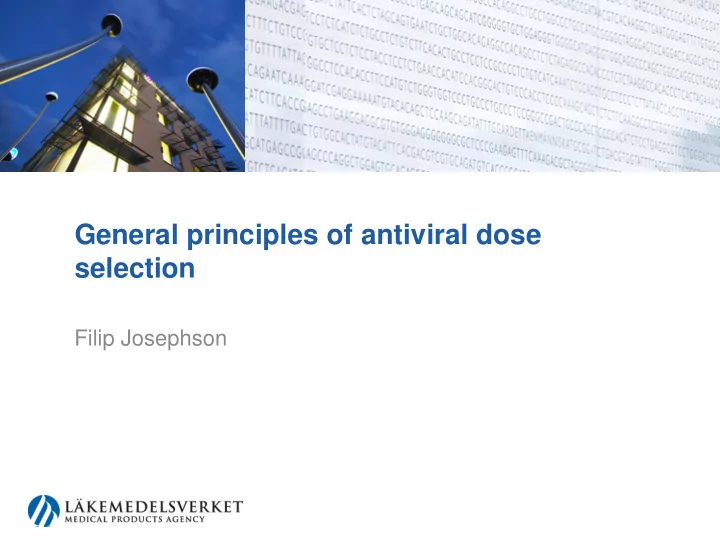

General principles of antiviral dose selection Filip Josephson
Principles of antiviral dose selection General scheme developed for HIV, subsequently applied, e.g., for hepatitis C • (protein binding adjusted) EC50 for wild-type virus and drug pressure emergent viral variants (escape mutants) determined in relevant in vitro expression system (covering, e.g., viral genotype/subtype diversity) No role for animal models for the determination of PK/PD relation (HIV, • hepatitis C) • Assumptions on target compartment exposure in relation to plasma exposure may be based on animal model (e.g., plasma to liver ratio) • In vivo dose/exposure relation and short term safety first investigated in healthy volonteers (HV) • PK target (generally Ctrough defined as some multiple of EC50) determined , taking EC50 of common escape mutants, that may reasonably be covered, into account Consideration of pharmacoenhancement (e.g, ritonavir boosting) with plasma • PK targets and general desire for once daily dosing in mind • Consideration of intracellular exposure and half-life in target cells (when known) if prodrug (e.g., nucleoside/nucleotide analogues)
Principles of antiviral dose selection (cont:d) • Initial dose ranging short term monotherapy study in patients with viremia (or in principle quantifiable viral nucleic acid levels on other matrix than plasma), with dose range selected based on HV dose/exposure relation and EC50-based PD target Selection of dose(s) for combination therapy studies based on efficacy against • wild-type virus (dominant circulating strain), inhibition of treatment emergent resistant variants and prevention of on-treatment viral rebound • Subsequent dose ranging in patients, in combination with other agents, aiming at finding dose yielding maximal viral suppression and prevention of virological breakthrough (=suppresssion of treatment emergent resistant variants) + safety characterisation • Usually but not always a single dose tested in phase III trials, which may compare different treatment strategies (e.g., combinations, regimens) • Adaptation of strategy possible depending on the viral syndrome to be treated (e.g., relevant animal model, no viremia, etc) • PK/PD modeling generally used to support decision-making along the way
Recommend
More recommend